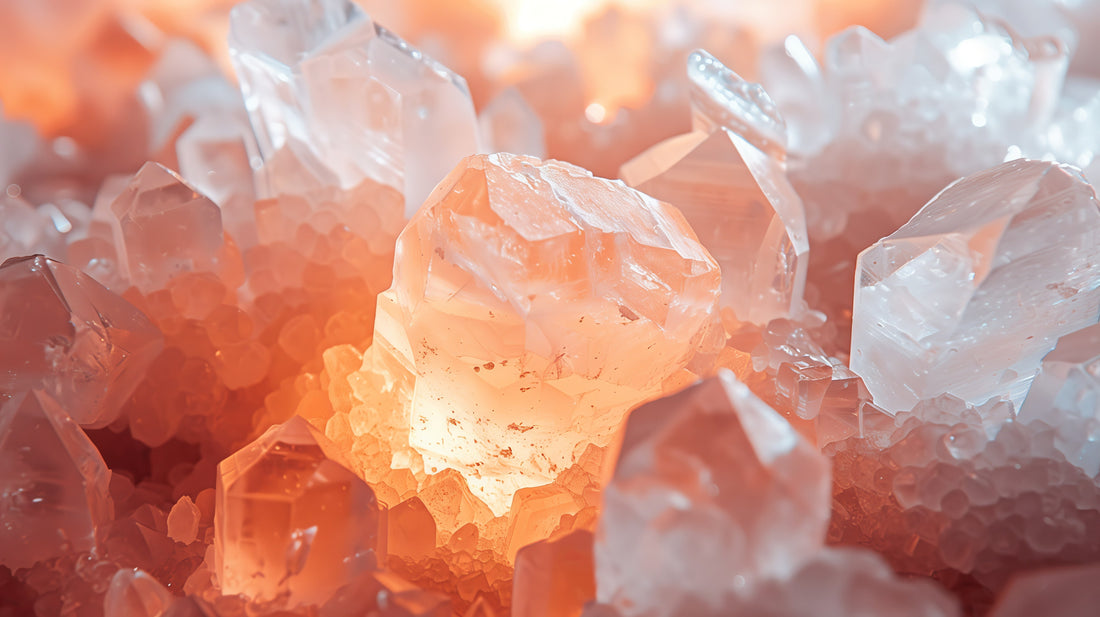Rock salt, also known as halite, is a fascinating mineral that has been an integral part of human civilisation for millennia. From seasoning our food to de-icing our roads, this versatile substance plays a crucial role in our daily lives. In this exploration, we'll delve into the world of rock salt, uncovering its origins, types, uses, and potential health benefits.
What Is Rock Salt?
Rock salt is a naturally occurring form of sodium chloride (NaCl) found in vast underground deposits. These deposits are the remnants of ancient seas that evaporated millions of years ago, leaving behind crystallised salt. Unlike sea salt, which is produced by evaporating seawater, rock salt is mined from the earth.
The formation of rock salt deposits is a fascinating geological process. As ancient oceans evaporated, the salt concentrated and crystallised, forming layers that were subsequently buried by sediment. Over time, these layers were compressed and transformed into solid rock salt formations.
The History of Rock Salt
The use of rock salt dates back to ancient times. Early civilisations quickly recognised its value, not only as a food preservative and flavour enhancer but also as a trading commodity. Salt routes, such as the famous Salt Road in Italy, were established to transport this precious resource.
In medieval Europe, salt was so valuable that it was often referred to as "white gold". It played a crucial role in preserving food before the advent of refrigeration, allowing for long-distance trade and exploration.
Types of Rock Salt
While all rock salt is essentially sodium chloride, there are several varieties distinguished by their origin, colour, and mineral content:
1. White Rock Salt
The most common variety, often used for de-icing and water softening. It's typically mined from large underground deposits and can be found in various grain sizes.
2. Pink Himalayan Rock Salt
Prized for its distinctive pink hue and trace mineral content. While the Khewra Salt Mine in Pakistan is the most famous source, pink salt is also mined in other regions of the Himalayan mountain range, including parts of India, Nepal, and Tibet. The colour and mineral content can vary slightly depending on the specific origin.
3. Grey Rock Salt
Contains trace minerals and is often used in cooking. It's typically less refined than white rock salt and retains some of the minerals from its original deposit.
4. Blue Persian Rock Salt
A rare variety with a striking blue colour due to structural aberrations in the crystal lattice. This unique salt is mined from ancient salt deposits in Iran.
5. Black Rock Salt (Kala Namak)
Popular in South Asian cuisine, this salt has a distinctive sulphuric smell and taste. It's actually pink to dark violet in colour when ground.
Is Himalayan Pink Rock Salt Good for You?
Himalayan pink rock salt has gained popularity in recent years, with many touting its potential health benefits. This food has small amounts of potassium, magnesium, and calcium.
Some proponents claim that Himalayan pink salt offers superior health benefits compared to regular table salt. However, nutritionists generally agree that the differences are minimal from a health perspective.
Himalayan pink salt contains minerals, but in very small amounts that may not provide much nutrition. Himalayan pink salt is high in sodium, which is essential for many bodily functions.
Uses of Rock Salt
Rock salt has several applications that take advantage of its specific properties. Here are some common uses:
1. De-icing
Due to its large crystals and low cost, rock salt is the preferred choice for de-icing roads and pavements. Its coarse texture provides traction on slippery surfaces while melting ice.
2. Water Softening
Rock salt's affordability and availability in bulk make it the go-to option for water softening systems in homes and industries.
3. Industrial Processes
In chemical manufacturing, rock salt is often preferred due to its purity and cost-effectiveness. It's used in chlor-alkali processes to produce chlorine and caustic soda.
4. Livestock Salt Licks
The large, solid blocks of rock salt are ideal for creating salt licks for livestock, providing essential minerals in a long-lasting form.
5. Food Processing
In large-scale food processing, rock salt is used for its consistent composition and lower cost compared to other salts, particularly in brine solutions for pickling and preserving.
6. Culinary Uses
While less common in home kitchens, rock salt's large crystals make it useful for certain culinary applications:
- Creating salt crusts on baked foods
- As a bed for baking or grilling foods
- In traditional ice cream makers to lower the freezing point of ice
7. Salt Therapy
Rock salt is used in salt caves and lamps for potential respiratory benefits, though scientific evidence is limited.
8. Decorative Purposes
Large rock salt crystals or carved lamps have become popular decorative elements, combining aesthetic appeal with claimed health benefits (though these are not scientifically proven).
Does Rock Salt Kill Weeds?
Yes, rock salt can kill weeds. Its high sodium content can disrupt the water balance in plants, effectively dehydrating them. When salt is applied to soil, it increases the soil salinity, making it difficult for plants to absorb water through their roots. This can lead to wilting and eventually death of the plant.
However, it's important to use this method cautiously, as salt can also damage soil quality and affect other plants. The salt can persist in the soil for a long time, potentially harming desirable plants and making it difficult for anything to grow in that area for years to come. For most gardeners, there are more eco-friendly weed control methods available, such as manual removal, mulching, or using organic herbicides.
Is Rock Salt the Same as Sea Salt?
While both rock salt and sea salt are forms of sodium chloride, they differ in their origin and processing:
- Rock salt is mined from underground deposits and often undergoes minimal processing. It's formed from the evaporation of ancient seas millions of years ago.
- Sea salt is produced by evaporating seawater and may retain trace minerals from the ocean. It's a more recent formation compared to rock salt.
In terms of taste and nutrition, the differences are generally subtle. Rock salt often has a more mineral taste due to its geological origins, while sea salt might have a more complex flavour profile depending on its source. The choice between the two often comes down to personal preference and intended use.
From a culinary perspective, sea salt is often preferred for its flavour and texture, especially as a finishing salt. Rock salt, due to its larger crystals, is often used in cooking processes where it will dissolve, like in boiling water for pasta or in brine solutions.
For more information on sea salt and its unique properties, check out our Comprehensive Guide to Sea Salt.
What Do Salt Rock Lamps Do?
Salt rock lamps, particularly those made from pink Himalayan rock salt, have become popular home accessories. These lamps consist of large chunks of salt with a light bulb inserted inside. When lit, they emit a warm, pinkish-orange glow that many find soothing.
Proponents claim these lamps can:
1. Salt lamps purify air by attracting water molecules and pollutants. The heated salt attracts water molecules and airborne pollutants, improving air quality.
2. Reduce electromagnetic radiation: Some believe that salt lamps can neutralise the negative effects of electronic devices that emit electromagnetic radiation.
3. Improving mood and sleep quality: Some believe that the soft, warm glow promotes relaxation and enhances sleep patterns.
4. Himalayan salt lamps may increase energy and focus by releasing negative ions, boosting mood and concentration levels.
Health Considerations
While rock salt is generally safe for consumption, it's important to be mindful of sodium intake. The primary component of rock salt, like all salts, is sodium chloride. Sodium is an essential nutrient that plays a crucial role in nerve and muscle function and helps maintain proper fluid balance in the body. However, excessive sodium consumption can lead to high blood pressure and other health issues.
The NHS recommends that adults should eat no more than 6g of salt a day (2.4g sodium) – that's around 1 teaspoon. (NHS Guideline: Read more about the NHS healthy eating tips). Many people consume much more than this, often without realising it, as a lot of sodium comes from processed foods rather than salt added during cooking or at the table.
When using rock salt or any other type of salt, consider the following:
1. Monitor your intake: Be aware of how much salt you're adding to your food.
2. Read food labels: Many packaged foods contain high levels of sodium.
3. Use other seasonings: Herbs and spices can add flavour without increasing sodium content.
4. Consider potassium: Foods high in potassium can help counteract some of sodium's effects on blood pressure.
Environmental Impact of Rock Salt Mining
While rock salt is a natural product, its extraction can have environmental implications. Big mining can harm nature and cause pollution if not controlled well.
Moreover, the use of rock salt for de-icing roads can have negative environmental effects. As the salt dissolves, it can run off into nearby soil and water bodies, potentially harming plants and aquatic life. Many municipalities are exploring alternatives or ways to minimise salt usage while still maintaining safe road conditions.
Conclusion
Rock salt, born in ancient seas and now an integral part of our daily lives, continues to prove its versatility and importance. This mineral marvel has transcended time, finding its way from prehistoric oceans to our modern kitchens, roads, and industries.
Rock salt isn't merely a seasoning; it's a testament to Earth's geological history. Its presence in our daily lives serves as a reminder of the intricate connections between our planet's past and present.

